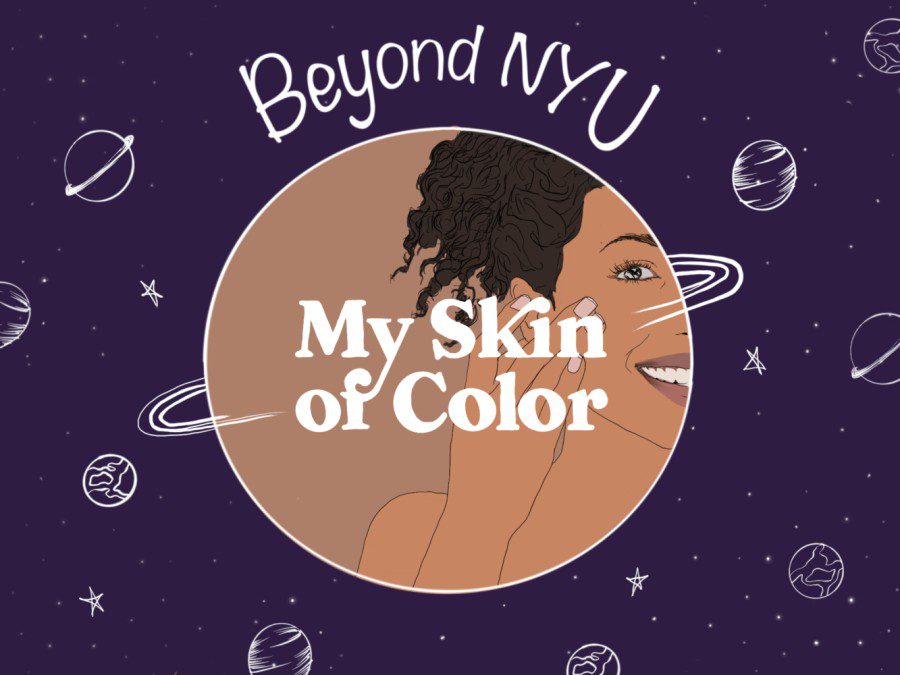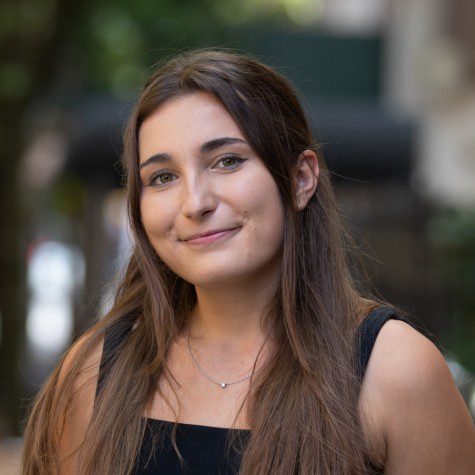Beyond NYU: Addressing historical injustices in dermatology
Each week, WSN sits down with an NYU student, faculty member or alum who’s making change beyond the university. Langone alum Gibran Shaikh shares how his dermatology company caters to people of color, treating conditions while keeping history in mind.
Dermatology company My Skin of Color seeks to address historical inequalities in healthcare. (Illustration by Aaliya Luthra)
October 14, 2022
Gibran Shaikh, a certified dermatologist and NYU Grossman School of Medicine alum, is seeking to address historical inequalities in healthcare through his recently launched dermatology company, My Skin of Color.
After training at Bellevue Hospital and in Baltimore — where Shaikh estimates that 70% to 80% of his patients were people of color — he began to see a pattern. He witnessed a racial gap in health literacy and made it his mission to make dermatology more accessible. Alongside his role as a clinical instructor in the department of dermatology at Mount Sinai’s Icahn School of Medicine, Shaikh practices out of Cobble Hill and Park Slope in Brooklyn, and now runs his own company.
In an interview with WSN, Shaikh spoke about how his time at NYU influenced his career in dermatology, discussed the modern day impacts of historical healthcare inequalities and shared his vision for the future of My Skin of Color.
This interview has been edited for length and clarity.
WSN: What led you to create My Skin of Color?
Shaikh: First of all, there’s this massive education gap in that a lot of conditions that affect people of color can like be treated by a doctor. I would get a lot of patients in my clinic in Baltimore that would beat around the bush — they wouldn’t know if their condition was something that I could treat. Similarly, with health literacy in my white patient population, if they had a little bit of redness or a little blood vessel, they would know exactly the laser that they want, and they know exactly the treatment. And then I would get my patients of color and they’d be so bashful. I’m like, “Listen, this is a medical condition. We’re going to treat it in the same way we treat any other skin condition.”
I realized that there were these persistent historical injustices in dermatology in how we talk about skin. This legacy of colorism makes it difficult and embarrassing for people of color to talk to their predominantly white doctors about their skin. If we have difficulty talking about our dark spots and our razor bumps in our bikini area in English, imagine you’re trying to do it in a language that’s not your own.
Shaikh said that a New York Times article titled “Dermatology Has a Problem With Skin Color,” which reported that many medical school textbooks do not include pictures of conditions that impact people of color, added to his growing interest in building his own company. He added that this lack of information in educational spaces often leads to delays in diagnosis and complications — something that he hopes to address with My Skin of Color.
When the pandemic hit, Shaikh saw an opportunity to use technology to make dermatology more accessible for communities of color. He said that the company’s online consultation model will help to address structural inequalities in the U.S. healthcare system. Potential clients can fill out an online form about the skin condition they are experiencing and are diagnosed by Shaikh himself. If they are prescribed medication, they can use their insurance to cover the cost.
WSN: Can you say more about the impacts of historical injustices in medicine and the impacts you see working in dermatology today?
Shaikh: There’s a legacy of great abuse and a lot of mistrust, particularly in the African American community, toward the healthcare industry. And it’s totally founded — this country has a lot of atrocities that have made it difficult for people of African American backgrounds to trust the healthcare system and to trust that the doctor has their best interests in mind.
Then you have this layer of technology, because it’s all done virtually, so it’s like “Who’s this guy behind the screen who’s looking at my very intimate photos and looking at my very intimate personal health information?” There’s this leap of faith aspect — that’s the most difficult thing to overcome. When you see the website, you don’t necessarily know who it is that you’re giving your information to, or how they’re going to protect it. Building trust in the context of the legacy of abuses in American healthcare has probably been the biggest difficulty.
WSN: How have you seen the impact of My Skin of Color so far?
Shaikh: There’s a lot of enthusiasm about the idea itself, because we live in this particular sociopolitical moment where issues that affect brown and Black people are coming to a head and people are more aware. People are excited that there’s a service that was designed not as an afterthought — like L’Oreal and La Roche-Posay, everybody wants to get in the skin of color game because they just see money. But for me, it’s skin of color first, and then everything else after that. That’s what it’s designed for, and I’m very unapologetic about what it is.
I’ve seen these network effects — when you treat someone well and they feel heard and validated, then they cannot help but tell their friends and anybody who listens.
My Skin of Color specifically targets 12 conditions and areas of dermatology: acne, anti-aging, dandruff, dark spots, excess underarm sweating, eyelash growth, itchy scalps, male pattern hair loss, melasma, razor bumps and rosacea. Currently, Shaikh conducts all consultations, and said he has seen between 25 and 30 clients since the company’s launch last month. A primary consultation costs a flat fee of $69, and follow-up consultations are cheaper.
The company’s services are only available in New York City for those 18 years and older, but Shaikh said he hopes to expand the company’s offerings soon. He also said that he wants to increase the scope of conditions that My Skin of Color specializes in as the company grows.
WSN: What do you envision for the future of My Skin of Color?
Shaikh: The legacy that I want to leave behind is transforming how we think about and talk about treating skin of color on a national scale. I want to influence the lives and benefit thousands or tens of thousands, or hundreds of thousands of people — not just however many I can see personally in a clinic. First and foremost, my goal is to expand to other states than New York state. We’re fortunate because at least in New York City, we have a lot of dermatologists. It may take forever to see one, you may get a referral from your primary doctor, your copay may be super high, you may need to get child care for your kid or take time for work, but at least the dermatologists are there. But in much of New York, that’s not the case, let alone more rural parts of America.
There’s that saying, “If you can make it in New York, you can make it anywhere.” So my first goal is to prove the concept and the demand for the service in New York City and state. Once it’s there and I understand the recipe, my goal is to go out to the entire country.
If you know of an NYU student, professor or alum making change beyond the university, contact [email protected].
Contact Abby Wilson at [email protected].

























































































































































